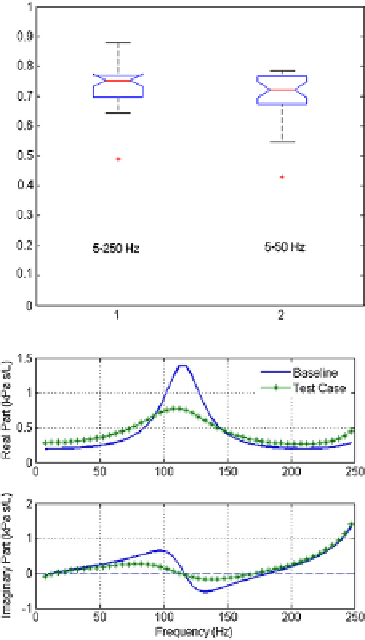Biomedical Engineering Reference
In-Depth Information
Fig. 7.38
Boxplot for the
fractional-order values
n
identified from the 31
volunteers
Fig. 7.39
The original
Z
PA R
impedance (
bold line
)as
identified for patient “22”
from Table
7.15
and the
modified impedance (
stars
)
with twofold increased
R
ts
(denoted in figure as “test
case”)
order parameter with frequency, we re-identify the ladder network model in the
range 5-50 Hz, and we obtained a new fractional-order value, depicted in Fig.
7.38
in the right-column. There was no statistically significant difference between the
two identified sets (
p<
0
.
7). This validates the expected theoretical result that the
fractional-order value is independent on the frequency.
Further on, the sensitivity of the fractional-order value to changes in mechanical
parameters has been evaluated by using
Z
PA R
with modified
R
ts
increased twofold,
and fitting
Z
REC
to it. Figure
7.39
shows the original
Z
PA R
impedance identified
for patient “22” from Table
7.15
and the modified impedance (denoted in figure as
“test case”). To the modified impedance (i.e. test-case impedance) we have fitted
the model of
Z
REC
asshowninFig.
7.40
and obtained the following parameter val-
ues:
R
ua
=
1
.
3
e
−
7
0
.
0017 (kPa s
2
/L);
C
ua
=
(kPa s/L);
L
ua
=
0
.
0034 (L/kPa);
R
=
0
.
0005 (kPa s
2
/L);
C
=
0
.
098 (kPa s/L);
L
=
0
.
0016 (L/kPa);
λ
=
1
.
10;
χ
=
0
.
52;
α
0
.
03. The simulated increase in tissue resistance is re-
flected by an overall increase in the airway resistance value and modified recurrent
ratio values. The resulting fractional-order value is then calculated from the identi-
fied recurrent ratios using (
5.38
), it following that
n
=
1
.
10 and total error
E
t
=
=
0
.
19. This implies that our
proposed model is able to capture variations in the respiratory parameters and the
fractional-order value is a suitable parameter for classification.

